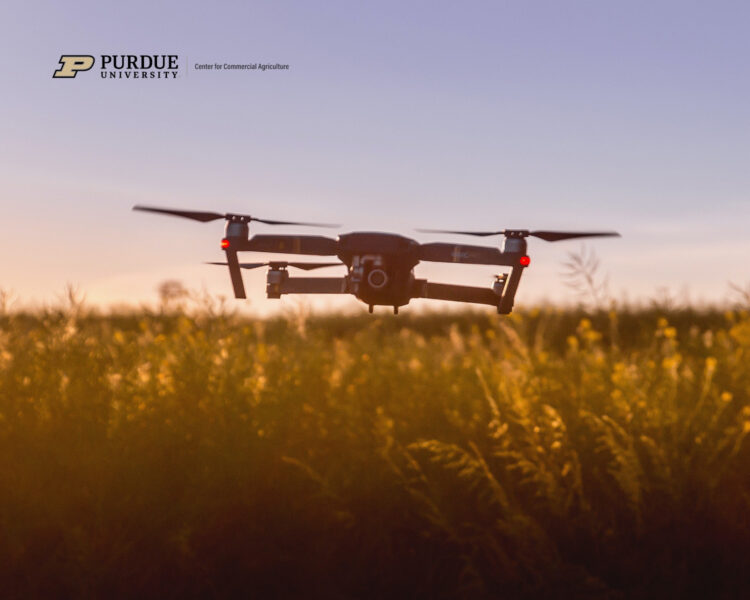March 18, 2021
The Role of Information in Today’s Uncertain Business Climate
by: Michael Langemeier and Michael Boehlje
Recent articles (March 5, 2021) and (March 12, 2021) discussed the importance of new technologies to crop agriculture and the value of information. In this article, we continue this theme by discussing the role of information in today’s uncertain business climate. Future articles will discuss possible payoffs of precision agriculture, automation and robotics, and gaps in skills pertaining to the adoption of new technologies.
The business climate regularly presents challenges to the profitability and financial performance of even well managed crop farms. Given expectations that crop prices and farm incomes will periodically come under pressure, it will be critical for farmers to “double down” on implementing the management strategies and practices to maintain or enhance profitability and reduce the prospects of financial deterioration of their businesses. What are some of the strategies and practices, and where is data and information essential to be “best in class”, irrespective of the business climate, to have the resiliency and agility to handle the kind of uncertainty farmers face?
1. Improve Efficiency and Productivity
Without a doubt high efficiency and productivity are essential for success. Doing everything you can to choose the right seed, fertility, pest control, and other agronomic inputs and practices that will generate the best economic yield is essential. Remember that the highest physical yield is not the best if the cost to obtain additional bushels is higher than the value of those additional bushels. But given the uncertainty in weather and prices, it is difficult to be exactly correct in your agronomic decisions, so it is often better to over-apply than under-apply fertilizer in particular (but not too much!) to capture the yield potential that is available.
2. Intense Cost Control
In a commodity industry like crop farming, you have to be a low-cost producer to be successful in the long-run. So, cost control is absolutely essential. Determining cost per unit of production (i.e. bushel of corn or soybeans) and detailing those costs by major category (for example, seed, fertilizer, chemicals, etc.) is one way to know which costs are the most important to focus on and attempt to reduce. One of the biggest cost categories is land cost. Rental payments on cash rented land have not adjusted down as much as most other input costs, and it is a difficult but important discussion to talk to your land owners and negotiate a lower or adjustable rental rate. How long can you hold on to a rental property if you are losing money and expect to continue to do so? Maybe you could negotiate a flexible cash lease (a lower base payment per acre with an additional payment if prices or yields exceed a specified level), or a crop- share lease arrangement.
3. Improve Execution
Get it done right and in a timely fashion. In manufacturing industries, this is known as “lean” production practices and procedures. Systemize the production processes by using check-lists and standard operating procedures (SOP’s) to make sure all the tasks necessary to produce a crop are done at the right time, in the right order and in the right way. Use the best data and information on field conditions and weather forecasts to schedule machine operations and sequencing of tillage, planting, and harvesting operations by field and location. Expand the number of hours in the field per day and/or increase your workforce to get the most work accomplished in the suitable field days during the growing season.
Maybe double or triple shift your field activities so you can operate as close as possible to 24 hours a day when field conditions allow you to do so. Use computer-based work flow scheduling procedures to plan your daily activities and have the capacity to quickly make the necessary adjustments when weather events or other interruptions such as equipment breakdowns disrupt your schedule.
4. Manage Margins
Projecting profit margins is not easy when you don’t know what prices and/or yields will be, but it is still useful to estimate your profit margin, and even more valuable to estimate it for different levels of prices and yields to determine the sensitivity of profit and cash flows to weather and market conditions. Determining potential margins per bushel of production requires estimates of costs per bushel which can also be useful in making marketing decisions. If product prices are above costs, maybe you should capture or lock in that margin/profit on some of your potential sales just in case market prices deteriorate in the future. And if you are projecting a negative margin and expect to lose money, it is important to know the size of the potential loss and develop a plan to make sure you can cover your financial commitments and not impede the survivability of the business.
5. Buy Right
Some businessmen say that the first and most important “marketing” decision they make is what inputs or raw materials they purchase and what they pay for them because that sets their cost structure. This is why most industrial manufacturing businesses have someone responsible for procurement (i.e., buying right). And certainly, particularly in farming, you have more control over costs than you do over market prices, so time spent on making the best decision on “buying right” is critical to financial performance. Comparing potential suppliers’ offers just like one compares the prices offered by different product buyers is an important task in buying right. One common practice in the business world is to use a “spec sheet” to systemize and document those offers (Boehlje and Downey, 2015). This spec sheet should include not just prices, but other features such as services included, performance guarantees or warranties, discounts if available, delivery conditions, information sources, contacts for complaint resolution, financing terms, etc.
6. Manage Operating Risk
Operating or business risk is the variability in the income generation and financial performance of the farm resulting from the variability in the prices, yield, and costs that the farm business faces. Managing this risk can almost be a full-time job. It involves choosing the right technology to reduce yield loss from weed and insect pests, from nutrient/fertility inadequacy or losses, seed that is not disease or weather resistant, equipment that is not reliable and subject to frequent breakdowns, etc. Operating risk can also result from marketing decisions that don’t recognize product price and basis volatility and input price increases. Choice of the government farm program options and the most appropriate crop insurance alternatives are important management strategies to manage operating risk, along with having the appropriate casualty and liability insurance program.
7. Debt and Capital Management
The capital structure of the business (the proportion of the assets financed with borrowed or lease funds compared to owner’s equity funds) is a critical source of financial risk. Common sense says a business has increased financial vulnerability as it relies on increased amounts of debt (and thus has a higher debt to asset ratio) to finance its activities. But there is more to it. Using short-term credit (an operating loan for example) to fund the purchase of a capital asset such as machinery or land can be a disaster if the operating line is reduced or not renewed in subsequent years. Loan repayment terms must be “matched” to the useful life of the asset so that earnings from using those assets can be used to service the debt. Lenders are interested not just in the total debt of a business, but the structure and repayment terms of that debt. And a premium is placed on the “liquidity” of the business as indicated by the amount of cash that will be generated during the normal business cycle from sales of products and inventories which will be available to make principle and interest payments on the debt. Lenders want a cushion or reserve in this “working capital” position so the scheduled payments can be made even if lower prices/yields or other factors reduce incomes or cash flows. Making the right choice to lengthen loan repayment terms, reduce capital expenditures, sell some underutilized assets to generate cash, use excess cash or negotiate a cash infusion from outside the business, or use some other strategy to respond if debt repayment problems are encountered is a difficult decision that is best avoided if possible by well-developed debt/capital management plans.
8. Simplification/Automation
One way to improve the operations/execution process and the accuracy of getting everything “done right” is to simplify the processes as much as possible. Complexity creates confusion and results in mistakes. This doesn’t mean taking “short-cuts” and not doing the critical tasks correctly. Rather, it means dropping the steps/activities that aren’t essential and making sure everyone is not just familiar with the SOP’s, but is actually using them to get the work done. And better yet, new precision farming technology (autonomous self-driving tractors, irrigation control systems, automated calibration of yield monitors, automated combine header and threshing controls, etc.) is increasingly making it possible to automate more and more farming activities.
9. Do Fewer Things Better
Unfortunately, many farmers suffer from the “jack of all trades, master of none” phenomena. They do not have the time/energy to be “best in class” in everything they do, so aren’t as successful as they might be. A standard question asked by consultants who specialize in business management is what do you do better than anyone else. In other words, what is your core competency? Figure out what you are really good at and then focus on continually getting better at it over time. But what about those activities that need to get done but you don’t have the time/energy to do them? Hire or retain someone who specializes in that activity, a standard practice for legal or accounting work. Maybe you need to do more “outsourcing” of other activities such as retaining a crop consultant or a market advisory service, hiring someone to custom spray your crops, or transporting the crop to the elevator. Focus on doing fewer things better.
10. Data Management
Just think about what your grandfather would say if he had all of the data and information that is now available to you to make farming decisions. Certainly, he would be concerned about “data overload” just like you are today, but the tools and techniques are increasingly available to sort through that data/information and make more informed and better decisions. No doubt you will need assistance in collecting the data and carefully analyzing it to sort-out false signals or noise from facts and true insight. But as we will discuss in an upcoming article, the payoff is there for time/energy/money spent on data management. The lynch-pin and common denominator of all these strategies and practices is to have the most accurate data and information as well as the appropriate analytics and decision processes to make the right choices and implement the best strategies. Digitization of agriculture and the significant advances in the development of precision agriculture tools and techniques have enhanced our capacity to adopt strategies that will improve resiliency and agility to respond in these increasingly uncertain times.
Concluding Comments
The increasing role that knowledge and information play in obtaining control of resources, increasing profits, and reducing risk in farming is occurring for two fundamental reasons. The first reason is the dramatic growth in knowledge and information of the chemical, biological, and physical processes involved in agricultural production. This vast expansion in knowledge and understanding means that those who can sort through that knowledge and information and put it to work in a practical context have a better chance of success. Second, the “food business” has become an increasingly sophisticated and complex business in contrast to producing commodities as in the past. This increased complexity means that those with more knowledge and information about the detailed processes as well as how to combine those processes in a total system (i.e. a food chain approach) will have a comparative advantage. Whereas the physical resources of land, labor, and capital were the key determinants of financial success in the past, the role of knowledge and information will become more important in the future. Superior knowledge and information will enable producers to more successfully obtain the physical resources of land, labor, and capital and combine them in an efficient manner. Thus, the role of knowledge and information to success in the farming sector and agricultural industry is more important today than ever before.
This article discussed the role of information in today’s uncertain business climate. Upcoming articles will discuss possible payoffs of precision agriculture, automation and robotics, and gaps in skills pertaining to the adoption of new technologies in production agriculture.
References
Boehlje, M. and S. Downey. “Buying (Selling) Inputs in the Current Business Climate.” Center for Commercial Agriculture, Purdue University, September 2015.
Boehlje, M. and M. Langemeier. “Importance of New Technologies for Crop Farming.” Center for Commercial Agriculture, Purdue University, March 5, 2021.
Boehlje, M. and M. Langemeier. “Information Technology and Value Creation.” Center for Commercial Agriculture, Purdue University, March 12, 2021.
Langemeier, M. “Identification of Unique Resources.” Center for Commercial Agriculture, Purdue University, June 3, 2016.
Pope, M. and S. Sonka. “Evidence, Data, and Farmer Decision Making.” farmdoc daily (10):45, Department of Agricultural and Consumer Economics, University of Illinois at Urbana-Champaign, March 11, 2020.
Thompson, N.M., C. Bir, D.A. Widmar, and J.R. Mintert. “Farmer Perceptions of Precision Agriculture Technology Benefits.” Journal of Agricultural and Applied Economics. 51(Issue 1, 2019):142-163.
TEAM LINKS:
PART OF A SERIES:
RELATED RESOURCES
Margaret Lippsmeyer presented during agri benchmark’s 2024 annual conference in mid June, which was hosted by the Spanish Ministry of Agriculture in Valladolid, Spain. An increase in soybean acreage may come from either (a) shifting away from continuous corn rotations to corn-soy and (b) shifting corn-soy rotations toward corn-soy-soy. Based on agri benchmark data, Margaret showed that option (a) would require an increase in soybean prices of 6% and option (b) of 8% to make these rotations preferable over existing ones.
READ MOREUPCOMING EVENTS
We are taking a short break, but please plan to join us at one of our future programs that is a little farther in the future.






